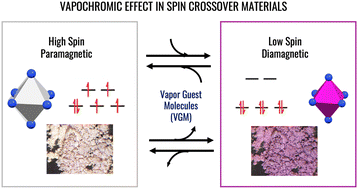Vapochromic effect in switchable molecular-based spin crossover compounds
Abstract
Coordination complexes based on transition metal ions displaying [Ar]3d4–3d7 electronic configurations can undergo the likely most spectacular switchable phenomena found in molecular coordination chemistry, the well-known Spin Crossover (SCO). SCO phenomena is a detectable, reproducible and reversible switch that occurs between the high spin (HS) and low spin (LS) electronic states of the transition metal actuated by different stimuli (i.e. light, temperature, pressure, the presence of an analyte). Moreover, the occurrence of SCO phenomena causes different outputs, one of them being a colour change. Altogether, an analyte in gas form could be detected by naked eye once it has triggered the corresponding HS ↔ LS transition. This vapochromic effect could be used to detect volatile molecules using a low-cost technology, including harmful chemical substances, gases and/or volatile organic compounds (VOCs) that are present in our environment, in our home or at our workplace. The present review condenses all reported iron coordination compounds where the colour change induced by a given molecule in its gas form is coupled to a HS ↔ LS spin transition. Special emphasis has been made on describing the nature of the post-synthetic modification (PSM) taking place in the material upon the analyte uptake. In this case, three types of PSM can be distinguished: based on supramolecular contacts and/or leading to a coordinative or covalent bond. In the latter, a colour change not only indicates the switch of the spin state in the material but also the formation of a new compound with different properties. It is important to indicate that some of the SCO coordination compounds discussed in the current report have been part of other spin crossover reviews, that have gathered thermally induced SCO compounds and the influence of guest molecules on the SCO behaviour. However, in the majority of examples in these reviews, the change of colour upon the uptake of analytes is not associated with a spin transition at room temperature. In addition, the observed colour variations have been mainly discussed in terms of host–guest interactions, when they can also be induced by a PSM taking place in different sites of the molecule, like the Fe(II) coordination sphere or by chemically altering its inorganic and/or organic linkers. Therefore, we present here for the first time an exhaustive compilation of all systems in which the interaction between the coordination compounds and the vapour analytes leads to a colour change due to a spin transition in the metal centre at room temperature.



 Please wait while we load your content...
Please wait while we load your content...